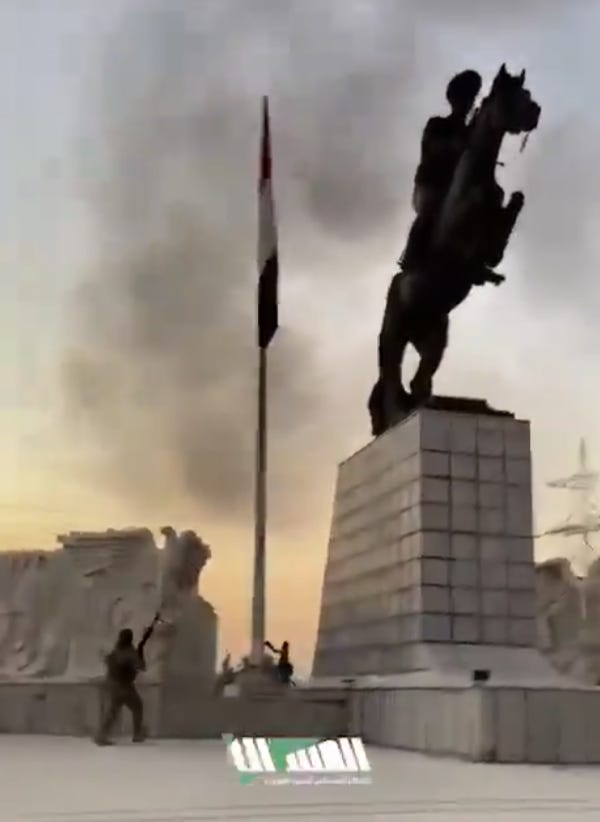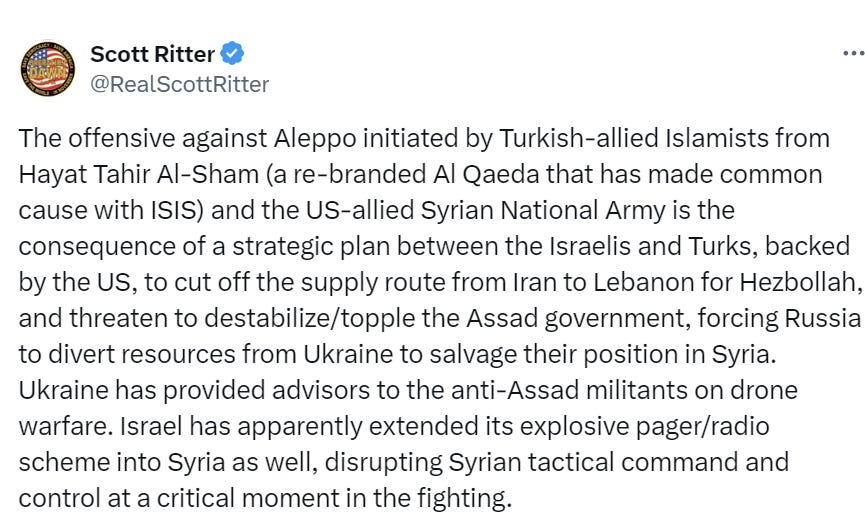Turkey strikes back! Where is the ceasefire now crowd now?
There are no good sides in the now re-started Syrian Civil War, but the anti-war movement in America would tell you otherwise.

To paraphrase the British writer Gerald Seymour, one man’s genocidal tyrannical monster is another man’s virtuous saviour of civilisation. This week after years of stalled fighting in an area known as the Idlib pocket near the Turkish border Syrian rebels burst through the lines of government forces in the northwestern part of country and are currently fighting in the Aleppo, its second city and scene of horrific battles from 2012 to 2016. Unfortunately “rebel” groups in Syria include a motley assortment of psychopathic killers, most of them jihadists and a fair amount of them not even Syrian but hailing from Sunni jihadist groups banned in their home countries like Turkmenistan. They are arrayed against Syrian President Bashar al-Assad, an ophthalmologist who was plucked from his practice to be the country’s president because his older brother Bassel had died in a car wreck of his Mercedes before his father, the long-time dictator Hafez al-Assad, died in 2000. The speed with which his forces have melted away illustrates that Assad’s grip on power may be weaker that anticipated.
Supporting Assad are the governments of Russia and Iran as well as a variety of Shiite Islamist groups including Hezbollah, and therefore there are some who are cheering for his overthrow as it serves the purpose of neutralising them. I’m not one of those people. Certainly I do have sympathy for Sunni Muslims in Syria who have languished under Assad, but that is balanced by my fear for the safety of Christians, Druze, and other minority religious communities in Syria that would be imperiled under a Jihadist government. A friend of mine reacted to events by saying that eliminating Assad, from America and Israel’s perspective, would be better because it would remove Iran’s influence, but that’s ignoring the previous example of the ISIS insurgency that rivaled or surpassed him in their depravity.
A recent Foreign Affairs article stated bluntly that “[f]or the Syrian government, Israel mostly serves as an object of public relations—an easy scapegoat to blame for its own failings, and to try to win favor from its Sunni population and Arabs across the region”, implying that the Assads only pay lip service to the Palestinian cause. This is one explanation as to why Assad has not directly intervened against Israel since the Oct. 7 attack by Hamas against Israel while his Hezbollah allies have taken the most active supporting role until recently. But based on recent events there is a bigger reason: Assad’s standing within his own country is so weak that he could not risk exposing his army (the SAA) in battle against a worthy opponent. We see that in the recent offensive by Hayat Tahrir al-Sham (HTS), the main Sunni rebel coalition, that has seized villages, outposts, cities, military bases and even air force bases from Assad with only token opposition.
Of course there is a vibrant community online of influencers who try to portray Assad as the greatest bulwark against Al-Qaeda that there is, rather than the ill-suited dilletante who owes his political survival to his strategic sponsors Russia and Iran. For them there can be only one culprit for this catastrophic failure, as you can see below.




Now, I would be remiss if I didn’t close by saying that the people creaming the SAA and toppling statues are themselves more dangerous than Assad himself, and perhaps even more than his allies potentially allowing for the resurgence of ISIS or a similar regime in Syria. I have seen videos of HTS or other rebel fighters humiliating corpses, executing disarmed POWs, and individuals wearing “PRESS” vests participating in the post-conquest destruction. If you are seeing their progress as “good for America” or “good for Israel” then you’re living in a simplistic fantasy. Below is a clip of a rebel moving through a formerly Iranian-held building and stripping it of regime and Iranian posters and flags. . . except he skips over the Palestinian flag.
And then there are the past ties between Syria’s opposition and the Palestinian Hamas organization which supported them for a period. Here is a photo of Khaled Meshaal (center holding the flag), the former head of Hamas’s external leadership chumming it up with Free Syrian Army supporters.
If some of you are confused, the Sunni Muslim majority Palestinians are not natural allies of Iran and Hezbollah who are Shiites. They regard the Assads, members of the even smaller Alawite faith, as heretics and enemies of Islam. In fact they have a long history of bloody battles and temporary truces with both Hafez (the War of the Camps in the 1980s) and Bashar al-Assad (battles of Yarmouk Refugee Camp), in which many Palestinian lives were wasted. Hamas and Iran use one another when convenient, and at times the former also solicits help from Recep Tayyip Erdogan, the autocratic Sunni Islamist leader of Turkey.
The regime that may take the place of Assad’s would at best likely resemble that of Turkey or Qatar, ruled by Islamists who seek to spread their influence wherever possible at the expense of Israel or more secular Arab neighbours like Jordan or Egypt. At worst it would be a jihadist state that would rival Afghanistan, and would be situated in the strategically critical eastern Mediterranean region. So to answer Gary Johnson’s question from 2016 “What is Aleppo?” Bad news, however you read it.




